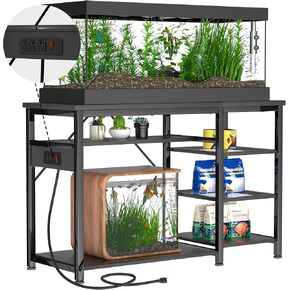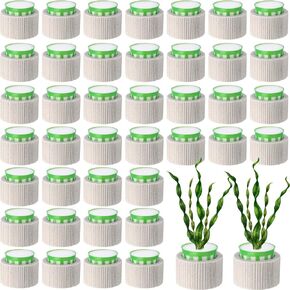- Shopping, made easy.
- /
- Get the app!
Overview: Hornwort (Ceratophyllum demersum) is a popular aquatic plant widely used in freshwater aquariums. It is a fast-growing, floating or submerged plant that provides numerous benefits to both the aquarium environment and its inhabitants. Morphology: Structure: Hornwort has a feathery, bushy appearance with thin, needle-like leaves that are typically arranged in whorls around the stem. The leaves can grow up to 10 cm (4 inches) in length and have a bright green color. Growth Habit: It can grow both submerged and partially floating, adapting to various aquarium setups. When floating, it can provide shade and cover for fish and other aquatic life. Root System: Hornwort has a minimal root structure that primarily serves to anchor the plant. It does not require substrate to thrive, making it ideal for various tank setups. Benefits in Aquariums: Water Quality Improvement: Hornwort absorbs excess nutrients, such as nitrates and phosphates, helping to maintain water quality and reduce algae growth. Oxygen Production: Through photosynthesis, hornwort releases oxygen into the water, which is beneficial for fish and other aquatic organisms. Habitat and Shelter: Its dense growth provides hiding spots for small fish, fry, and invertebrates, reducing stress and promoting natural behaviors. Aesthetic Appeal: The lush, green appearance of hornwort enhances the visual appeal of aquariums, creating a natural and vibrant environment. Care Requirements: Lighting: Hornwort thrives in a range of lighting conditions, from low to bright light. However, moderate to high light levels promote faster growth and denser foliage. Temperature: It prefers water temperatures between 20°C to 24°C (68°F to 75°F) but can tolerate a broader range. pH Level: The ideal pH for hornwort is between 6.0 and 7.5, but it is adaptable to various water conditions. Nutrient Needs: While hornwort can grow in low-nutrient environments, providing additional fertilizers can enhance growth, particularly in planted tanks. Propagation: Hornwort propagates easily through vegetative means. As the plant grows, it produces side shoots or branches. These can be cut and replanted in the aquarium to create new plants. Floating fragments can also establish themselves if they find suitable conditions. Compatibility: Hornwort is compatible with a wide variety of freshwater fish and invertebrates. It does particularly well in community tanks and can be used alongside other aquatic plants like Anubias or Java Fern for a diverse setup. Conclusion Hornwort is an excellent choice for aquarium enthusiasts due to its ease of care, aesthetic appeal, and beneficial properties. It enhances water quality, provides habitat for aquatic life, and contributes to a balanced ecosystem. Whether you are a beginner or an experienced aquarist, incorporating hornwort into your aquarium can significantly enhance the health and beauty of your aquatic environment.
 40-55 Gallon Fish Tank Stand: Heavy Duty Aquarium Stand with Power Outlets and Cabinet for Fish Tank Accessories Storage - Metal Frame, 1000LBS Capacity, Suitable for Fish & Reptile Terrariums
KWD 59
40-55 Gallon Fish Tank Stand: Heavy Duty Aquarium Stand with Power Outlets and Cabinet for Fish Tank Accessories Storage - Metal Frame, 1000LBS Capacity, Suitable for Fish & Reptile Terrariums
KWD 59
 -23%
Unocho Aquarium Rock Stone Fish Tank Rocks 3-6inches Natural Aquarium Rocks 4PCS for Aquariums Landscaping Model Tank Decoration Aquarium Miniature and Fairy Garden Fish Tanks -5LB
KWD 8.500
-23%
Unocho Aquarium Rock Stone Fish Tank Rocks 3-6inches Natural Aquarium Rocks 4PCS for Aquariums Landscaping Model Tank Decoration Aquarium Miniature and Fairy Garden Fish Tanks -5LB
KWD 8.500
 Nuanchu 4 Set Acrylic Fish Tank Divider 11.4 x 9.75'' Aquarium Divider Kit Splicable Flexibly Aquarium Divider with Suction Cups Accessories Splicing Board for 30/40/50/65/75/90/125/150 Gallon Tank
KWD 16.500
Nuanchu 4 Set Acrylic Fish Tank Divider 11.4 x 9.75'' Aquarium Divider Kit Splicable Flexibly Aquarium Divider with Suction Cups Accessories Splicing Board for 30/40/50/65/75/90/125/150 Gallon Tank
KWD 16.500
 50 Pack Aquarium Plant Weights Fish Tank Plant Holder Ceramic Anti Floating Aquatic Aquarium Pots Fixed Ring Set for Landscape Decoration Accessories
KWD 12.500
50 Pack Aquarium Plant Weights Fish Tank Plant Holder Ceramic Anti Floating Aquatic Aquarium Pots Fixed Ring Set for Landscape Decoration Accessories
KWD 12.500